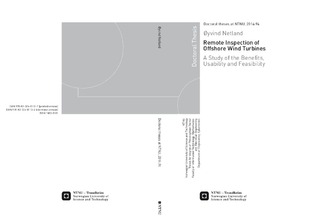| dc.contributor.author | Netland, Øyvind | nb_NO |
| dc.date.accessioned | 2014-12-19T14:08:49Z | |
| dc.date.available | 2014-12-19T14:08:49Z | |
| dc.date.created | 2014-04-04 | nb_NO |
| dc.date.issued | 2014 | nb_NO |
| dc.identifier | 710080 | nb_NO |
| dc.identifier.isbn | 978-82-326-0112-7 (printed version) | nb_NO |
| dc.identifier.isbn | 978-82-326-0113-4 (electronic version) | nb_NO |
| dc.identifier.uri | http://hdl.handle.net/11250/261141 | |
| dc.description.abstract | Offshore wind turbines are large, unmanned machines that are deliberately located in areas with strong wind. Access to the turbines is expensive and time consuming, and in periods of harsh weather, the turbines can be inaccessible. This is challenging for operation and maintenance of the turbines, and the same maintenance strategies that have been used successfully on land will not necessarily be viable offshore.
This thesis suggests the use of a remotely controlled robot that can be used to inspect a turbine without accessing it. The robot is intended to be installed inside the wind turbine nacelle and move on a rail. Since access to the turbine is not needed, inspections can be done inexpensively, with less planning and regardless of the weather. This concept has been evaluated with the NOWIcob tool and the simulation results indicated that it would have a positive effect on the availability and cost of energy for offshore wind turbines.
A remote inspection robot prototype has been developed, and used for evaluation of the concept in four experiments. These were usability tests, where participants did both remote inspections using the prototype and manned inspections. Two of the experiments were pilot experiments with 4 participants each. The two larger experiments had 21 and 31 participants. Observations and participants’ suggestions from each of the experiments were used to improve the prototype, following a user-centered development method. This is a commonly used method within human-computer interaction to improve the usability of a system. The results from the last experiment were the most accurate due to an improved experiment procedure and the largest number of participants. They showed that remote inspection was almost as effective as manned, and that remote inspections would likely perform better if more time had been available.
To simplify the development of the prototype’s control system, a method for using code generated from MathWorks Simulink Coder, called Software Module Real-time Target (SMRT), was developed. It is intended for embedded developers that would like to include code generated by Simulink Coder into a larger software project. It has been designed to be used with only a minimal knowledge of Simulink Coder. As SMRT by itself can be of interest for other developers, it has been described in its own chapter. The code is also available as open source online.
The experiments presented in this thesis mark the end of the work with the current prototype and the laboratory testing. The experiments have demonstrated the plausibility of using a telerobot for remote inspections, with almost the same effectiveness as manned inspection. The experience gained from these experiments will be brought into the next phase, which will be the development of a new prototype for installation in a real wind turbine. The laboratory evaluation has been an important and necessary step in the development of such a system. | nb_NO |
| dc.language | eng | nb_NO |
| dc.publisher | Norges teknisk-naturvitenskapelige universitet, Fakultet for informasjonsteknologi, matematikk og elektroteknikk, Institutt for teknisk kybernetikk | nb_NO |
| dc.relation.ispartofseries | Doktoravhandlinger ved NTNU, 1503-8181; 2014:94 | nb_NO |
| dc.relation.haspart | Netland, Øyvind; Skavhaug, Amund. Adaption of MathWorks Real-Time Workshop for an Unsupported Embedded Platform. Conference Proceedings of the 36th EUROMICRO Conference on SoftwareEngineering and Advanced Applications: 425-430, 2010. <a href='http://dx.doi.org/10.1109/SEAA.2010.53'>10.1109/SEAA.2010.53</a>. | nb_NO |
| dc.relation.haspart | Netland, Øyvind; Skavhaug, Amund. Prototyping and Evaluation of a Telerobot for Remote Inspection of Offshore Wind Farms. 2nd International Conference on Applied Robotics for the Power Industry: 226-231, 2012. <a href='http://dx.doi.org/10.1109/CARPI.2012.6473351'>10.1109/CARPI.2012.6473351</a>. | nb_NO |
| dc.relation.haspart | Netland, Øyvind; Skavhaug, Amund. Two pilot experiments on the feasibility of telerobotic inspection of offshore wind turbines. Conference Proceedings of the 2012 Mediterranean Conference on Embedded Computing: 46-49, 2013. <a href='http://dx.doi.org/10.1109/MECO.2013.6601378'>10.1109/MECO.2013.6601378</a>. | nb_NO |
| dc.relation.haspart | Netland, Øyvind; Skavhaug, Amund. Software Module Real-Time Target. 39th EUROMICRO Conference on Software Engineering and Advanced Applications: 232-235, 2013. <a href='http://dx.doi.org/10.1109/SEAA.2013.51'>10.1109/SEAA.2013.51</a>. | nb_NO |
| dc.relation.haspart | Netland, Øyvind; Jenssen, Gunnar Deinboll; Schade, Hilde Marie; Skavhaug, Amund. An Experiment on the Effectiveness of Remote, Robotic Inspection Compared to Manned. Conference Proceedings of the IEEE International Conference on Systems, Man, and Cybernetics: 2310-2315, 2013. <a href='http://dx.doi.org/10.1109/SMC.2013.395'>10.1109/SMC.2013.395</a>. | nb_NO |
| dc.relation.haspart | Netland, Øyvind; Jenssen, Gunnar D.; Skavhaug, Amund. Evaluation of Remote Inspection of Offshore Wind Turbines with a Tablet Controlled Telerobot. . | nb_NO |
| dc.relation.haspart | Netland, Øyvind; Skavhaug, Amund. A Review of Experiments Evaluating the Usability of Mobile Telerobots. . | nb_NO |
| dc.title | Remote Inspection of Offshore Wind Turbines: A study of the Benefits, Usability and Feasibility | nb_NO |
| dc.type | Doctoral thesis | nb_NO |
| dc.contributor.department | Norges teknisk-naturvitenskapelige universitet, Fakultet for informasjonsteknologi, matematikk og elektroteknikk, Institutt for teknisk kybernetikk | nb_NO |
| dc.description.degree | PhD i teknisk kybernetikk | nb_NO |
| dc.description.degree | PhD in Engineering Cybernetics | en_GB |

